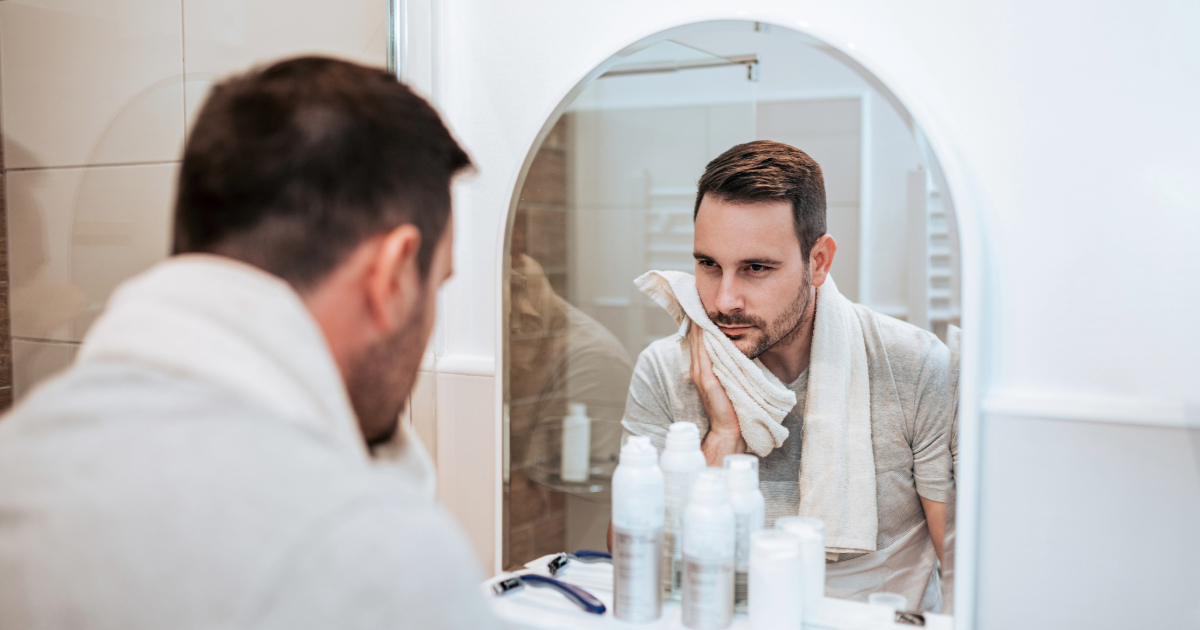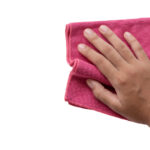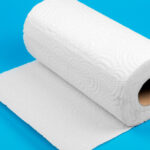If you’ve ever found yourself wondering about the differences between a face towel and a washcloth when stocking your linen closet or shopping for bath textiles, you’re not alone.

Though they serve similar purposes, these two types of small towels have some key differences that set them apart.
Defining Face Towels and Washcloths
First, let’s start by clearly defining what face towels and washcloths are:
Face towel: A small, square-shaped towel made from soft, gentle materials designed specifically for delicate facial skin. Usually measures about 12″ x 12″ or 13″ x 13″. Key uses include gentle face cleansing, makeup removal, drying skin after washing, applying skincare products.
Washcloth: A small rectangular towel usually made from cotton terry or looped pile fabric. Slightly larger than a face towel. Typical size is around 16″ x 30″ or 13″ x 18″. Main uses include bathing, body cleansing, exfoliating, applying soap/body wash in the shower.
So in summary:
- Face towels cater to the sensitive skin on your face, while washcloths are better suited for the rest of your body
- Face towels have a small, square shape made to fit facial contours, washcloths are longer rectangular towels
- The materials and sizes make each optimal for different purposes
Now that we’ve defined both towel types, let’s look at some other key differences.
Size Differences Between Face Towels and Washcloths
One of the most noticeable differences between these two towels comes down to size.
Face towels are smaller, typically measuring about 12″ to 13″ square. This compact size allows a face towel to be maneuvered around the sensitive areas of the face more easily.
Washcloths are slightly larger, with the most common sizes ranging from 13″ x 18″ up to 16″ x 30″ rectangular.
Having a larger surface area makes a washcloth better suited for use on the body, legs, back and other areas that require covering more skin real estate.
Here’s a helpful table comparing some standard face towel and washcloth dimensions:
| Towel Type | Common Sizes |
|---|---|
| Face Towel | 12″ x 12″ 13″ x 13″ |
| Washcloth | 13″ x 18″ 16″ x 30″ |
So if you’re trying to tell the difference between these two towels, size is an easy way to identify them. Just remember face towels are smaller squares and washcloths are larger rectangles!
Materials for Face Towels vs. Washcloths
When it comes to materials, face towels and washcloths each have certain fabrics that tend to work best:
Best Materials for Face Towels
Since face towels make direct contact with sensitive facial skin, they call for extra soft and gentle fabrics like:
- Turkish cotton: Organic Turkish cotton has long fibers that create a super soft and plush towel. Great for sensitive complexions.
- Bamboo: Bamboo fabric is naturally smooth and antimicrobial. Good for acne-prone or irritated skin types.
- Microfiber: Ultra-fine microfiber texture doesn’t irritate. Effectively cleans skin without tugging.
- Organic cotton: Unprocessed organic cotton maintains soft comfort next to delicate facial tissue.
The most important factor is choosing a material with a soft hand-feel and subtle texture that won’t scratch or bother facial skin.
Top Washcloth Fabric Options
For washcloths that are used primarily on the body, some fabrics that offer the best durability and cleaning ability include:
- Cotton terry: The terry loop pile traps moisture while the cotton absorbs well and launders easily.
- Bamboo rayon: Bamboo viscose rayon is very absorbent, sustainable, and antimicrobial.
- Turkish cotton: High-end Turkish cotton washcloths provide softness with good absorption.
- Microfiber synthetic: Budget-friendly microfiber washcloths are very scrubby for exfoliation.
Washcloths tend to need a fabric that can stand up to frequent use and regular laundering. Cotton terry is one of the most popular choices as it offers great versatility at an affordable price point.
When Should You Use a Face Towel vs a Washcloth?
Now that you know the differences between materials, sizes, and intended uses, when should you actually use a face towel versus a washcloth?
Situations calling for a face towel:
- Cleansing facial skin
- Applying facial products like toners, serums, & masks
- Gently drying the face after cleansing or showering
- Removing make-up around the delicate eye area
- Blotting away facial oil throughout the day
A face towel is specifically intended for use on the face and nowhere else! Keeping face towels separate maintains proper hygiene and prevents transferring dirt or bacteria from the body onto the sensitive facial tissue.
Good times to use a washcloth:
- Scrubbing the body while bathing
- Applying soap, body wash or shower gel
- Exfoliating rough areas like feet, knees and elbows
- Getting a better lather from soap products
- Washing at a basin or sink when a full shower isn’t needed
Washcloths offer slightly more abrasive scrubbing power making them ideal for lathering up soap products and sloughing away dead skin. Just avoid rubbing them too aggressively across your facial skin!
Keeping designated face towels and washcloths for their intended purposes ensures you get the best specialized fabric and texture for taking proper care of your face versus the rest of your body.
How Often To Wash and Replace Face Towels vs Washcloths
Proper laundering is also key to ensuring towels stay fresh and last over time. Here’s how often face towels and washcloths should hit the laundry:
Face towels accumulate makeup, dirt, oils and skin care residues so they require washing after every single use. Aim to change out your face towel daily if possible.
Washcloths can go 2-3 uses between washes since they mostly contact bare clean skin rather than accumulating facial products. Still, swap it out at least a few times per week.
And when it comes to replacement:
- Plan to replace face towels every 3-6 months
- Budget to swap out washcloths about once a year
The more frequently you launder and replace them, the longer both types of towels will maintain better hygiene and performance.
Pro Tips for Caring for Face Towels and Washcloths
To keep both face towels and washcloths looking and feeling their best, keep these expert care tips in mind:
- Wash new towels first to remove manufacturing residues
- Avoid using fabric softener to prevent buildup that reduces absorbency
- Disinfect periodically by washing with hydrogen peroxide, vinegar, or tea tree oil
- Air dry thoroughly to prevent mildew and maintain softness
- Store in a dry place to prevent musty smells from moisture
Proper washing methods and storage habits can help boost longevity of all your bath textiles.
And if you notice issues like lingering odors or lackluster absorbency, try washing with white vinegar or baking soda to remove buildup and restore performance.
Key Takeaway: Face towels and washcloths have different intended uses and require specialized materials and care to properly serve facial skin versus the body. Follow the fabric recommendations and cleaning guidelines to get the most out of each type.
FAQs
Should you use a washcloth on your face?
It’s best practice to only use towels designated specifically as face towels on your facial skin rather than standard washcloths. Delicate facial tissue calls for softer materials and gentler scrubbing touch than what washcloths are designed to provide.
What fabric is best for face towels?
Super soft fabrics like Turkish cotton, microfiber, bamboo and organic cottons make the best face towel options. These materials all offer smooth textures that won’t irritate easily inflamed or sensitive complexions.
Are microfiber towels good for your face?
Yes, ultra-fine microfiber is an excellent face towel fabric choice. Microfiber towels offer softness to pamper facial skin while also providing effective cleansing ability to remove dirt, oil and makeup thanks to the dense woven texture.
What can I use if I don’t have a face towel?
In a pinch, a small clean section of a t-shirt or very soft washcloth could work. Just be extra gentle about rubbing it on your facial skin compared to a towel made specifically for the face. You could also use plain water and your clean hands to rinse the face if no towels are available.
Should you wash your face before or after a shower?
Dermatologists typically recommend cleansing your face as the last step of your shower. Let the steam and heat from showering first help open your pores and soften any debris in them. Then use your face wash as the final step before toweling off to remove impurities from deep within clean pores.
How often should you wash face towels?
For proper hygiene, it’s ideal to wash face towels after every single use. The goal is to never rub a dirty towel filled with bacteria, leftover makeup, or built up skincare products back onto your clean skin.
What is the best towel material for sensitive skin?
If you have easily inflamed or sensitive skin, stick to super soft organic materials like bamboo, Turkish cotton, or long-staple Egyptian cotton. Avoid scratchy synthetics or cheap towels with short fibers that can be harsh on delicate skin types. Prioritize softness and gentleness when shopping for the best face towels or washcloths to pamper your sensitive complexion.
Should you wash face towels separately?
It’s generally recommended to wash face towels separately from body towels or other linens. Facial towels tend to need more frequent washing plus come in contact with residue from make-up and skin care products. Washing them separately ensures these products fully rinse clean rather than getting redeposited on body towels in the same load.
How do you sanitize face towels?
First wash face towels in hot water to help kill bacteria. Then periodically disinfect by adding 1/2 cup hydrogen peroxide, white vinegar or tea tree oil to the wash cycle. Finally, always allow face towels to fully air dry between uses to prevent mold or mildew growth in damp towels.
What is the most hygienic face towel to use?
For maximum facial hygiene, 100% microfiber or bamboo rayon towels are very effective choices. These fabrics have natural antimicrobial properties to inhibit bacteria growth. Or look for towels with embedded silver fiber technology to fight odor and germs. Change out facial towels daily for best results.
Should you dry your face with a dirty towel?
Absolutely not! Always use a fresh, clean towel on your facial skin. Dirty towels can harbor bacteria and redeposit impurities back onto your face. To prevent breakouts or irritation, dry with a fresh face towel or disposable paper towel if your cloth towels are all dirty.
Conclusion
face towels and washcloths are designed for different but complementary purposes.
Face towels offer a smaller size and gentler materials specifically for delicate facial skin. Their primary uses include gentle cleansing, drying, and applying skincare products to the face.
Washcloths provide a larger surface area and more durability for scrubbing the body with their typical terry or textured materials. They work well for exfoliating, soaping up, and general bathing needs.








